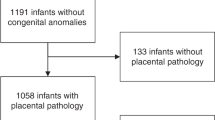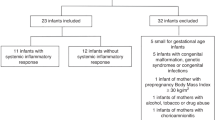Abstract
Objective:
Many different factors are involved in the pathogenesis of preterm deliveries and among them maternal or perinatal infections and inflammatory response have the major role. Researches were carried out about resistin, which is thought to have a role in inflammatory cytokine cycle and it was shown to be associated with growth in neonates. However, no research has been carried out showing its relationship with inflammation in neonates. In this study, we aimed to evaluate the resistin levels in premature neonates and the effect of events such as preterm prelabour rupture of the membranes (PPROMs) and the use of antenatal steroids on these levels.
Study Design:
The study included 118 preterm neonates. Their medical data together with their mothers’ were recorded. Serum resistin levels together with interleukin (IL)-6, C-reactive protein (CRP) and procalcitonin were evaluated in the first 2 h of life.
Result:
Mean gestational age and birth weight of babies included in the study were 29.6±2.7 weeks and 1306.4±393.4 g, respectively. Babies with PPROMs had significantly higher levels of resistin ((n=30); 70.7 (7.8 to 568.4) ng ml–1) than babies without PPROM ((n=88); 25.9 (5.5 to 528.9) ng ml–1) (P=0.005), and the babies of mothers who received antenatal steroids had significantly lower resistin levels ((n=44); 20.8 (5.5 to 159.9) ng ml–1) than the babies of mothers who did not ((n=66); 34.6 (7.2 to 568.4) ng ml–1) (P=0.015). There were significant correlations between resistin and IL-6 levels and between IL-6 and procalcitonin and CRP levels in babies whose mothers did not receive antenatal steroids. However, no correlation was found between these parameters in babies whose mothers received antenatal steroids.
Conclusion:
Preterm delivery and PPROM involve complex cascade of events including inflammation, and steroids are potent anti-inflammatory agents. Elevated resistin levels in babies with PPROM and suppressed levels in babies whose mothers received antenatal steroids reported in this study might have been observed as a result of the effects of fetal inflammation on resistin levels.
This is a preview of subscription content, access via your institution
Access options
Subscribe to this journal
Receive 12 print issues and online access
$259.00 per year
only $21.58 per issue
Buy this article
- Purchase on Springer Link
- Instant access to full article PDF
Prices may be subject to local taxes which are calculated during checkout
Similar content being viewed by others
References
Cornette L . Fetal and neonatal inflammatory response and adverse outcome. Semin Fetal Neonatal Med 2004; 9: 459–470.
Than NG, Kim SS, Abbas A, Han YM, Hotra J, Tarca AL et al. Chorioamnionitis and increased galectin-1 expression in PPROM—an anti-inflammatory response in the fetal membranes? Am J Reprod Immunol 2008; 60: 298–311.
Balk RA . Steroids for septic shock: back from the dead? (pro). Chest 2003; 123: 490S–499S.
Bolt RJ, van Weissenbruch MM, Lafeber HN, Delemarre-van de Waal HA . Glucocorticoids and lung development in the fetus and preterm infant. Pediatr Pulmonol 2001; 32: 76–91.
Been JV, Rours IG, Kornelisse RF, Lima Passos V, Kramer BW, Schneider TA . et al. Histologic chorioamnionitis, fetal involvement, and antenatal steroids: effects on neonatal outcome in preterm infants. Am J Obstet Gynecol 2009; 201: 587–589.
McTernan PG, Kusminski CM, Kumar S . Resistin. Curr Opin Lipidol 2006; 17: 170–175.
Tilg H, Moschen AR . Adipocytokines: mediators linking adipose tissue, inflammation and immunity. Nat Rev Immunol 2006; 6: 772–783.
Pang S, Le Y . Role of resistin in inflammation and inflammation-related diseases. Cell Mol Immunol 2006; 3: 29–34.
Silswal N, Singh AK, Aruna B, Mukhopadhyay S, Ghosh S, Ehtesham NZ . Human resistin stimulates the pro-inflammatory cutokines TNF-α and IL-12 in macrophages by NF-κB-dependent pathway. Biochem Biophys Res Commun 2005; 334: 1092–1101.
Haugen F, Drevon CA . Activation of nuclear factor-κB by high molecular weight and globular adiponectin. Endocrinol 2007; 148: 5478–5486.
Motojima K . The physiological role of resistin and its connection with metabolic diseases. J Endocrinol Invest 2003; 26: 1171–1173.
Ng PC, Lee CH, Lam CW, Chan IH, Wong E, Fok TF . Resistin in preterm and term newborns: relation to anthropometry, leptin, and insulin. Pediatr Res 2005; 58: 725–730.
Jansson N, Nilsfelt A, Gellerstedt M, Wennergren M, Rossander-Hulthén L, Powell TL et al. Maternal hormones linking maternal body mass index and dietary intake to birth weight. Am J Clin Nutr 2008; 87: 1743–1749.
Gohlke BC, Bartmann P, Fimmers R, Huber A, Hecher K, Roth CL . Fetal adiponectin and resistin in correlation with birth weight difference in monozygotic twins with discordant growth. Horm Res 2008; 69: 37–44.
Cho GJ, Yoo SW, Hong SC, Oh MJ, Kim T, Kim HJ et al. Correlations between umbilical and maternal serum resistin levels and neonatal birth weight. Acta Obstet Gynecol Scand 2006; 85: 1051–1056.
Martos-Moreno GA, Barrios V, Sáenz de Pipaón M, Pozo J, Dorronsoro I, Martínez-Biarge M et al. Influence of prematurity and growth restriction on the adipokine profile, IGF1, and ghrelin levels in cord blood: relationship with glucose metabolism. Eur J Endocrinol 2009; 161: 381–389.
Mamì C, Marseglia L, Manganaro R, Saitta G, Martino F, Gargano R et al. Serum levels of resistin and its correlation with adiponectin and insulin in healthy full term neonates. Early Hum Dev 2009; 85: 37–40.
Briana DD, Boutsikou M, Baka S, Gourgiotis D, Marmarinos A, Hassiakos D et al. Perinatal changes of plasma resistin concentrations in pregnancies with normal and restricted fetal growth. Neonatology 2008; 93: 153–157.
Kusanovic JP, Romero R, Mazaki-Tovi S, Chaiworapongsa T, Mittal P, Gotsch F et al. Resistin in amniotic fluid and its association with intra-amniotic infection and inflammation. J Matern Fetal Neonatal Med 2008; 21: 902–916.
Street ME, Volta C, Ziveri MA, Viani I, Bernasconi S . Markers of insulin sensitivity in placentas and cord serum of intrauterine growth-restricted newborns. Clin Endocrinol 2009; 71: 394–399.
Struwe E, Berzl GM, Schild RL, Dötsch J . Gene expression of placental hormones regulating energy balance in small for gestational age neonates. Eur J Obstet Gynecol Reprod Biol 2009; 142: 38–42.
Lago F, Dieguez C, Gómez-Reino J, Gualillo O . The emerging role of adipokines as mediators of inflammation and immune responses. Cytokine Growth Factor Rev 2007; 18: 313–325.
Kunnari A, Ukkola O, Päivänsalo M, Kesäniemi YA . High plasma resistin level is associated with enhanced highly sensitive C-reactive protein and leukocytes. J Clin Endocrinol Metab. 2006; 91: 2755–2760.
Lappas M, Yee K, Permezel M, Rice GE . Release and regulation of leptin, resistin and adiponectin from human placenta, fetal membranes, and maternal adipose tissue and skeletal muscle from normal and gestational diabetes mellitus-complicated pregnancies. J Endocrinol 2005; 186: 457–465.
Acknowledgements
This study was supported by the Mother and Child Health Foundation.
Author information
Authors and Affiliations
Corresponding author
Ethics declarations
Competing interests
The authors declare no conflict of interest.
Rights and permissions
About this article
Cite this article
Gursoy, T., Aliefendioglu, D., Çaglayan, O. et al. Resistin levels in preterms: are they influenced by fetal inflammatory course?. J Perinatol 31, 171–175 (2011). https://doi.org/10.1038/jp.2010.103
Received:
Revised:
Accepted:
Published:
Issue Date:
DOI: https://doi.org/10.1038/jp.2010.103



